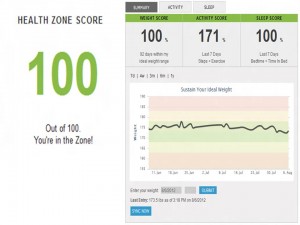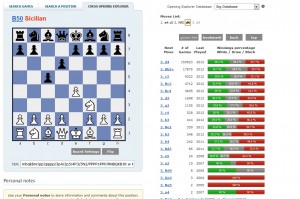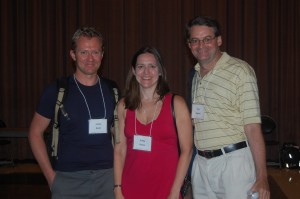Note: The book has come back to me for copy-editing, that’s why blogging is slow.
The “safe starches” panel turned out to be not about starches, but about carbs. Nobody wanted to contest my assertion that some starchy plants are free of toxins after cooking, so the criticism of starchy foods was solely based on perceived risks from their carb content.
The expectation going in was that Drs. Ron Rosedale and Cate Shanahan would be taking anti-starch/anti-carb positions and that Chris Kresser and myself would take pro-starch/pro-carb positions. But as it turned out, we arrayed ourselves on a spectrum. Ron was resolutely anti-carb, repeating his assertion that we’re all diabetics and intolerant of carbs (see Ron’s summary of the panel here); Cate was more moderate. I supported eating ~30% of calories as carbs, with lower-carb ketogenic dieting as a therapy for certain conditions. Chris took the position that there is little evidence favoring any carb intake over another, and that some cultures have been healthy on carb intakes as high as 85% or more. (See Chris’s summary of his remarks.)
A fair part of the discussion was about longevity and aging, and whether carbs contribute to it. This is a topic that has not been explored much in the Paleo blogosphere, and was the most interesting part of the panel for me.
[Photo from Diana Carr on Facebook.]
My Position: About 30% Carbs is Best
I took an evolutionary perspective. Evolution selected for a carb intake around 30% to 35% of calories. At lower carb intakes, protein is converted to glucose by gluconeogenesis; at higher carb intakes, significant amounts of the excess carbohydrate are converted to fat (not in the liver, but in skeletal muscle and adipose tissue; this is why studies examining lipids exported from the liver show minimal glucose to fat conversion).
If it were equally healthy for the body to have some other glucose supply than the one provided by a carb intake of ~30% of calories, then evolution would not have selected for mechanisms to restore this favored glucose supply by gluconeogenesis or lipogenesis. The body would have accommodated other levels of glucose utilization without trying to alter its glucose supply.
Further, we know that when carb intake is below this natural level, gluconeogenesis does not fully make up the glucose deficit; and when carb intake is above this natural level, lipogenesis does not fully eliminate the glucose surplus. As a result:
- On high-carb diets, cells/tissues utilize more glucose than in the evolutionarily favored state.
- On low-carb diets, cells/tissues utilize less glucose than in the evolutionarily favored state.
My thesis is that there are undoubtedly negative effects from over- or under-utilization of glucose by tissues; else evolution wouldn’t be trying to mitigate the over- or under-supply by lipogenesis and gluconeogenesis. And we know at the extremes that negative effects do occur:
- On very high-carb diets, eg macrobiotic diets, lipid deficiencies appear, reflected in reduced serum cholesterol, impaired immunity, and often mood disorders. We’ve blogged about the effects of lipid-deficient diets in infants.
- On very low-carb diets, we often see deficient production of mucus and tears due to downregulation of mucin production. We’ve blogged about this.
On less extreme divergences of carb intake from the evolutionary norm, there are no obvious acute effects, but the possibility exists of long-term negative effects.
Ron’s Misunderstanding of My View
Ron Rosedale seems to have misunderstood my argument. In his “A Conclusion to the Safe Starch Debate,” Ron asserts that I am concerned only with blood glucose levels. No, not at all: I am concerned specifically NOT with blood glucose levels but with tissue glucose utilization.
Perhaps a metaphor may help. Imagine an oil well facility connected by pipeline to an oil-burning power-plant. Suppose that it is essential to always maintain a certain pressure of oil in the pipeline, or the pipeline will suffer damage. When the oil wells produce more oil – say, because a new well has become a gusher – the power-plant burns more oil in order to maintain the proper pipeline pressure. When the oil wells produce less oil – say, they’re down for maintenance – the power-plant uses less oil. Always the pipeline has the same amount of oil.
Even though the pipeline always has the same amount of oil and the same oil pressure, that doesn’t mean that it doesn’t matter how much oil is entering the pipeline. The whole complex of wells-pipeline-powerplant may work best and be most robust to trouble if a normal amount of oil is being produced at the well end and a normal amount is being consumed at the powerplant end. Extreme levels of oil production may strain the powerplant’s ability to operate – insufficient oil may shut it down, and excess oil may burn it up or strain its facilities.
In the same way, eating too few or too many carbs will not affect the levels of glucose in the blood – these must be maintained above 60 mg/dl if glucose is to enter the brain which is essential for life even under ketosis – but may strain or stress our tissues which must downregulate or upregulate their utilization of glucose to match the flux of carbs into the body.
Cate Shanahan’s Experience
Cate Shanahan mostly discussed her experiences recommending a low-carb diet to her patients. She says that none of her patients have reported glucose deficiency symptoms, such as dry eyes. For me this mystery was cleared up when she said that she recommends her patients get 70 g of carbs daily. I and others have found that 50 g of starch is a sort of magic level that usually eliminates acute symptoms like dry eyes. So Cate appears to be recommending a level of carb intake that minimizes the risk of acute symptoms.
It wouldn’t surprise me if most of her patients are eating much more than 70 g. We know the food reward system strongly rewards carb consumption, so that nearly every culture on earth eats at least 45% carbs by calories. Quite possibly most of her patients are eating PHD levels, 100 g to 200 g.
Is there a counter-argument to my evolution based view?
To date, I’ve seen two counter-arguments:
(1) From the low-carb side, chiefly Ron Rosedale: Evolution didn’t optimize for longevity but for fertility, and we want longevity, therefore we should resist adopting the evolutionarily favored diet.
(2) From the high-carb side, voiced to some degree by Chris Kresser in the panel: Why isn’t a negative effect of high or low carb intakes apparent in epidemiological data? There seem to be healthy long-lived societies with high carb intakes.
These seem to me to be the interesting issues coming out of the safe starch debate. I will only give brief answers here.
Contra Ron: Very low-carb for longevity
I have two replies to Ron’s argument that very low-carb diets will maximize longevity.
First, evolution DID select for human longevity. The maximum human lifespan is double that of chimps and gorillas. Humans have mitochondrial membranes selected for extreme longevity. Both of these points are discussed in our new Scribner edition. This should give us confidence that the 30% carb intake selected for by evolution may well be the carb intake that maximizes longevity. I believe it is.
Second, Ron’s arguments are based on Cynthia Kenyon’s experiments in the nematode worm C elegans, in which she found that mutations to Daf-2, which is an insulin-like receptor in C elegans, extended maximum lifespan. Cynthia Kenyon famously switched to a low-carb diet after these experiments. However:
- Humans have multiple genes which are analogs to Daf-2, including insulin-like growth factor 1 as well as insulin, and IGF-1 appears to be more strongly related to longevity than insulin in humans. More significantly, insulin actually antagonizes Daf-2 in worms, inhibiting its signaling; calling into question whether Daf-2 biology can tell us anything about the effects of insulin signaling in humans.
- More importantly, the mutations to Daf-2 extend maximum lifespan in the laboratory, but they shorten expected lifespan under natural environmental conditions. When Daf-2 mutant worms are placed in the soil, they live shorter lives.
I made the second point during the panel. Here is the reference:
C. elegans mutants that live twice as long as wild-type worms in laboratory conditions typically die sooner than wild-type worms in a natural soil. These results indicate that conclusions regarding extended longevity drawn from standard laboratory assays may not extend to animals in their native environment. [1]
Even if Daf-2 mutant worms were an adequate model of human longevity, we would have to confront the issue of the robustness of health and longevity to stressors such as infections.
The death of Roy Walford, calorie restriction practioner and longevity guru, at age 79 from ALS – a disease that is promoted by fasting and calorie restriction – should warn us about the risks of extreme diets. There are pathogens that can exploit every human environment. “Feed a cold, starve a fever”; for different germs you may need different diets.
Evolution selected for a moderate carb intake because it makes us robust against a wide range of threats. Carb restriction, like calorie restriction, might protect us from some threats but expose us to others. In our natural, free-living situation, we’ll come up against every threat sooner or later. Just because an extreme diet may have the potential to extend our lifespan does not mean that it will. It may reduce our expected lifespan by making us vulnerable to new threats. The safest course, I think, is to follow evolution’s guiding hand.
What Does Experience on High-Carb Diets Tell Us?
Chris Kresser cited a number of healthy high-carb cultures, and noted that Okinawans became the world’s longest-lived culture after being forced to an 85% carb diet during World War II and its aftermath. Stephan Guyenet cites this as a telling point of the debate:
One of the most surreal moments happened right after Kresser brought up the Okinawans, the longest-lived culture and one of the healthiest in the world, and cited a paper showing that their traditional diet was ~85 percent carbohydrate, mostly from sweet potatoes. Shanahan and Rosedale decided, based on thin air, that the Okinawans actually didn’t eat much carbohydrate, and Shanahan even went so far as to say “I don’t believe you”, even though Kresser was staring right at the citation on his laptop! This is the kind of head-in-the-sand approach to science that we need to move beyond in the ancestral community.
The source for an Okinawan diet of 85% carbs was published in 1949, and the data was gathered during the post-World War II US occupation. This was a time of desperate poverty, and indeed followed years of poverty and famine during the Great Depression and World War II. Let’s not forget that the Chinese civil war was taking place during this period, and the Korean War was about to begin. Shou-Ching’s parents lived through this period, in China and Korea, and it was a time of starvation for them and for many others in east Asia.
All deeply impoverished people around the world eat high-carb diets, because carb-rich plants are the most readily available “fallback foods” in the natural environment and the cheapest calories available on the market. As soon as animal foods become available, cultures around the world migrate to 50% carb diets.
We have testimony from Okinawans who lived at that time telling us how difficult it was to obtain food. Their diet was severely calorie-restricted. I recall one Okinawan centenarian on television stating that they ate many kilograms of vegetables each day, simply because there was nothing else. (It rather resembled the Terry Wahls diet – very micronutrient rich.)
Then, decades later, the Okinawans become noted for their longevity. What produced the longevity – the carbs or the calorie restriction? Most likely the calorie restriction and high levels of nutrition were more important than the carb-to-fat ratio.
Food quality is also a factor. As readers of our book know, we think traditional Pacific islander diets are the healthiest in the world – composed of safe starches, coconut, and fish, very low in sugar and omega-6 fats. Whatever the carb fraction, such diets are healthier than the American diet. If there is a place in the world to survive a starvation diet of foraged and locally grown foods, it is a Pacific island.
My view: It was silly of the anti-carb panelists to refuse to credit the Okinawan data, but it is also misleading to say that the “traditional diet” of Okinawans is 85% carb based on data from a period of starvation and food scarcity.
As I noted in the panel, when people are able to eat as many calories as they wish, carb intake is generally anti-correlated with longevity at a population level: higher carb intake is associated with shorter expected lifespan. This is mainly due to the correlation of higher carb intake with poverty, but it occurs even within smaller samples of countries at similar income levels. For instance, among the European countries, higher carb intake is associated with shorter lifespan.
As I stated in the panel, this is extremely weak evidence for an effect of carbs; there are many confounding factors and population-level data cannot sort these out (the “ecological fallacy”).
Personally, I give more credence to data on centenarian diets. Few supercentenarians eat high-carb diets, so carbs may indeed reduce maximum lifespan, though eating a high-carb diet certainly doesn’t prevent people from becoming centenarians. (Supercentenarians live to 110.)
How carbs affect appetite may be more important than specific biological effects of glucose (or insulin). As the Simpson & Raubenheimer “protein leverage hypothesis” data show, in rodents higher carb diets are associated with higher calorie intake. Perhaps something similar occurs in humans. We know that energy excess and calorie restriction are major factors in longevity.
In short: I personally think that the relationship of carbs to longevity is U-shaped, with longest expected lifespans at a 30% carb intake; and I think available data is consistent with this. But I think the influence of carbs on longevity is small compared to other factors.
Conclusion
I was concerned going in that the panel would merely re-hash old arguments. I think the anti-carb arguments were, for the most part, familiar and weak; but I think the discussion took us to interesting places. I think the issue of the healthfulness of very high-carb diets, and the data from cultures like Okinawans, is a very interesting topic; and I think the issues of aging and longevity are quite interesting. I enjoyed the panel.
There are some health conditions which benefit from low-carb eating. I am grateful to our moderator, Jimmy Moore, for allowing me to enumerate some of the health conditions that have benefited from the ketogenic version of the Perfect Health Diet.
All in all, I think it was a good discussion but if it is to continue either the very low carb advocates will need to come up with better arguments and better evidence, or the topic will have to shift to exploring the merits of high-carb diets – a topic which the ancestral community hasn’t spent much time discussing.
Reference
[1] Van Voorhies WA, Fuchs J, Thomas S. The longevity of Caenorhabditis elegans in soil. Biol Lett. 2005 Jun 22;1(2):247-9. http://pmid.us/17148178.

















Recent Comments